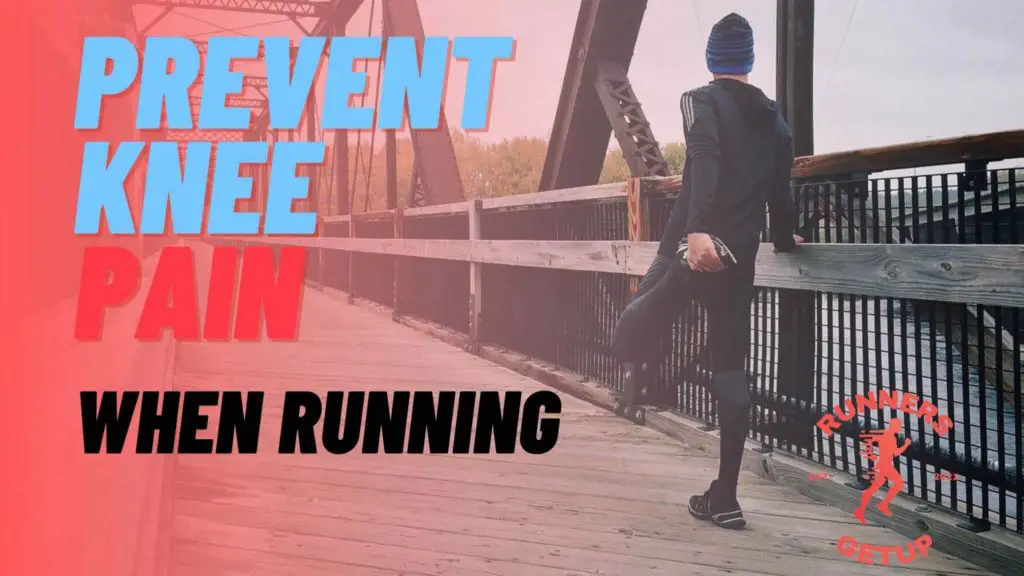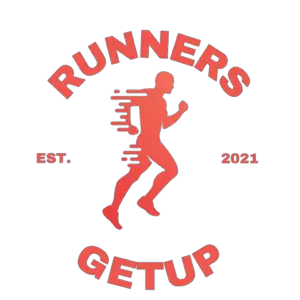This post contains affiliate links.
Knee pain is a common complaint of leisure and professional runners alike. It’s the result of the repetitive and high-impact nature of running. But is there a way to prevent knee pain when running? And if so, how? I asked a group of physiotherapists and here’s what they have to say…
Preventing knee pain is a combination of best practices including proper warm-up, incorporating strengthening and stretching exercises, adding variation to your runs, wearing the right running shoes, and adequate rest.
Seems easy, isn’t it? But the whole context of that information can’t be summarized in one phrase. Ahead we will get into more detail on how to prevent knee pain. I will also give you actionable steps along with recommendations that can help you prevent your knees from hurting.

Common Causes of Knee Pain For Runners
Before we dive into the actual steps on how to prevent knee pain, let’s look at some of the most common causes or injuries that can cause knee pain for runners.
Before the medical names of these syndromes scare you off, I would like to point out that I made an effort to try to explain these so that someone without a medical background can easily understand.
It’s important to learn about this stuff because it will help you find the source of the problem and incorporate the appropriate actions to solve it rather than throwing a bunch of generic solutions to a specific problem.
Patellofemoral Pain Syndrome
So far, the most common cause of knee pain for runners is Patellofemoral Pain Syndrome. You may have heard of it as Runner’s knee (although runner’s knee can be a bunch of different conditions leading to anterior knee pain).
It’s caused by several factors including:
- Overuse – the repetitive stress of running can irritate the area under your kneecap.
- Muscle imbalances – muscles around your hips and knees are unbalanced, creating misalignment in your kneecap
- Muscle weakness – weakness in other areas of your body including your core and glutes is also a culprit of patellofemoral pain syndrome
- Foot pronation – sometimes the source of the problem isn’t at the knee itself but somewhere else. In the case of fat footed people, your foot can roll inward during footstrike resulting in a chain reaction that ultimately leads to more stress on the knees
Iliotibial Band (ITB) Syndrome
Another common cause of knee pain in relation to running is the iliotibial band syndrome. It’s the most common cause of knee pain that presents as lateral knee pain or pain on the outside portion of the knee.
According to Physiopedia, the current theory is that the pain is caused by the compression of an innervated local adipose tissue during footstrike due to the tension in the iliotibial band.
Often, ITB syndrome is associated with underlying weakness in the hip abductors.
ITB syndrome is very common amongst long-distance runners, and runners running on banked grounds.
8 Ways To Prevent Knee Pain When Running
As a graduate of physical therapy myself, I took the time to ask a couple of my friends who are working as sports rehab therapists and looked into my old books for specific steps you can take to prevent knee pain when running.
1. Do Dynamic Warm-Ups Before Running
You might’ve heard about the importance of warm-ups before, but do you know how to do them the right way?
For many of us, we learned warm-ups from PE class which involve stretching different muscle groups for a couple of seconds, but warm-ups should never be about stretching.
In fact, static stretching before running can even affect your performance. I covered more of that in detail in a separate article.
Instead, warm up by gradually increasing your activity to keep your heart pumping and your blood circulating.
They’re also a good way to increase the synovial fluid or the lubricant within your knees for pain-free running.
Do exercises that activate your glutes and core to make sure they do their job when you run.
Here’s a video of an effective warm-up routine that you can follow before every run.
2. Strengthen Muscles Around Your Hips, Knees & Ankles
Preventing knee pain doesn’t only happen while you’re running or when you’re about to run. Rather, it’s a continuous process that includes incorporating a proper strengthening program.
Obviously, you want to strengthen muscles around your knees, particularly your quadriceps and hamstrings.
But you also need to strengthen the muscles around your hip and ankle in order to create stability, maintain proper running form, and support your knee joint.
As we’ve discussed earlier, patellofemoral pain syndrome and iliotibial band syndrome can both be caused by muscle weakness around the hip muscles.
So it makes perfect sense to strengthen muscles around your hips, particularly your glutes. Here are some exercises you can incorporate:
- Glute bridges
- Fire hydrants
- Step-ups
- Side squats (with band)
- Bulgarian split squats
If you don’t know where to start, there’s a paid 12-week program you can follow to strengthen your glutes specifically for running.
What I like about it compared to the free videos on the internet is that it’s a complete step-by-step program of what you should do.
It includes self-screening, strength exercises for all levels, hip mobility routines, stability exercises, and running drills. It also explains the idea behind what you’re doing.
It’s called the Glute Kickstart Program for Runners and you can access it through the link provided.
3. Build Up Your Mileage Slowly
In some cases, the cause of your knee pain might be because you’re drastically increasing your weekly mileage.
Maybe because you have an upcoming marathon and you’re cramming in your training in a limited time, or maybe you’re a beginner who just fell in love with running and decided to “catch up” with other runners.
If you’ve been reading running books or have been researching on the internet, there’s a good chance that you’ve encountered the 10% rule.
Essentially, what that is is a protocol that states that you should never increase your total weekly mileage by more than 10% each week.
That means if you run 30 miles this week, don’t run more than 33 miles the following week. It’s that simple.
To prevent knee pain, always remember the 10% rule and incorporate it into your program.
If you’re wondering how many miles do runners run a week, be sure to check out an article I made answering that specific question.
4. Stretch After You Run
Muscle weakness isn’t the only culprit for muscle imbalance but it could also be muscle tightness.
After you run, be sure to stretch the muscles involved such as your quads, glutes, and calves to prevent them from tightening up.
Stretching duration varies, some people need only a minute per muscle group while others need up to 5 mins.
I talked about stretching duration in detail in another article. If you’re interested in that information, be sure to check it out.
And, since we’re on the topic of stretching, we might as well touch on other recovery techniques such as foam rolling.
Spend a minute or two foam rolling before stretching to improve the rate of recovery.
Related post: Are Foam Rollers Good For Runners? (Based on Science)
5. Consider Trail Running Every Once In A While
Trail running is a great way to add another variety to your training while reducing the stress on your knees.
The trail offers soft ground that helps absorb some of the impacts from running. In addition, trail running is one great way to create a workout variation.
Since most running knee injuries are associated with the repetitive nature of running, trail running is a great way to create a different but similar movement pattern while still training for the same sport.
The varying degrees of elevation also help develop the muscles that are underutilized when running on flat surfaces such as the glutes and the core.
And if you remember what we’ve discussed earlier, you know that strengthening your glutes and core helps prevent knee pain.
Related post: 8 Ways Trail Running Helps Improve Road Running
6. Bike, Swim, Or Hike On Some Days
Another way to train your cardiovascular endurance without pounding on your knees is to bike, swim, or hike on some days.
It is commonly referred to as crosstraining.
It helps reduce the stress on your knees without actually taking a day off.
This strategy is particularly helpful for those who are training for a race and don’t want to reduce their training volume.
Personally, I prefer to hike some days of the week. Mountain hiking is a good cardiovascular exercise and is a great way to strengthen your legs, glutes, and core at the same time.
7. Wear A Proper Running Shoe
A running shoe is designed to support the high-impact nature of running.
They’re equipped with a high level of cushioning to help absorb the impact of running. They’re also shaped to support your running gait cycle which helps reduce strain on your body.
So if you’re thinking about using a regular athletic shoe for running, consider this a warning that you’re in for a lot of future pain.
Also, there are shoes designed for overpronators or runners whose ankles roll inward during footstrike.
These are called stability shoes. It helps correct your pronation by providing support on the inner part of your feet to prevent them from rolling in.
By the way, if you’re still figuring out what shoes to buy, the Brooks Ghost 14 is definitely one you should check out.
8. Take A Day Off
Finally, never underestimate the importance of full rest days.
And by full rest days, I mean sit on your couch and do nothing.
Rest days help your body recover, heal, and adapt to the physiological changes introduced by your training.
Should I Stop Running When My Knees Are Hurting?
The answer varies from runner to runner. It also varies depending on the severity and irritability of your knee pain.
If your knees are easily irritated and are experiencing severe pain, then you should stop and consult a rehab specialist regarding your condition.
On the other hand, if your knee pain is less severe and doesn’t get irritated easily, then you can just reduce the overall volume or intensity of your exercises until it gets better.
In some cases, taking a week off or choosing a different form of exercise for a week usually eliminates the pain.
Does Knee Pain Go Away On Its Own?
In some cases, knee pain goes away on its own without any intervention. However, while the pain is gone, leaving it does not solve the problem.
When you’re experiencing knee pain when you run, there is an underlying condition that causes it.
It could be muscle weakness, muscle tightness, or improper running form. To deal with knee pain permanently, you need to deal with the root of the problem.
That could be done through a series of strengthening and mobility exercises aimed to fix a specific problem in your body.
The best advice I could give you if you’re experiencing recurring knee pain is to consult a medical professional so he or she can give you a specific program to address your problem.
Alternatively, you can follow the Runner’s Knee Rehab Plan developed by James Dunne aimed to address the common biomechanical causes of knee pain.
Conclusion
Preventing knee pain is a combination of art and science.
You have to have the art to develop a program that addresses common muscle weaknesses and imbalances, and the science to figure out what’s wrong with your knees.
Although there are several best practices you can incorporate to prevent knee pain, the best option is still to hire a professional who can make their individual assessments and give you a specific program to address your problem.
This post was reviewed by a registered physical therapist.

